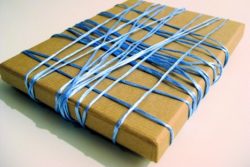In the wake of my mother’s death I’ve been thinking a lot about objects. This is in part because boxes of her things have been shipped to me—dishes, jewelry, stacks of old photos and albums—and it has been a challenge to figure out how to quickly find homes and purposes for all of these items. Usually objects arrive in a household one at a time—a kitchen knife, a piece of pottery, a pair of earrings—and one individual thing quickly folds itself into the community of other objects. But what should I do with this onslaught of new arrivals? Many of them are not things I knew my mother had. I have no sentimental attachment to them. Should I value them simply because they belonged to my mother? Is it permissible to toss out some of these things?
Stymied by these questions, I have stashed most of the boxes in a closet, still packed. A few items, however, leapt to immediate utility: a set of not-too-big, not-too-small bowls that are useful for cereal or soup, and a threadbare red summer-weight LL Bean bathrobe. These items are things I remember my mother using; they have a history and I, too, have come to use them, not with nostalgia exactly, but with a sense of carrying something forth, and an unexpected pleasure in the objects themselves.
The culture is very sanctimonious these days about the danger of attachment to objects. Attachment to objects harms the culture, harms the self. The decluttering mania is almost a movement. Books and articles abound. Getting rid of the excess objects in our lives will make us more focused, more whole, more spiritual, the declutterers seem to be claiming. I certainly appreciate the fact that objects can sometimes make our lives more complicated than necessary. They often require maintenance and upkeep. They cost money that might sometimes be used in better ways. Many objects have a short shelf-life so they quickly become trash. And when one moves—well, who doesn’t wish to own less stuff. So, yes, there are many reasons to be wary of acquiring too many objects.
But—
Human beings are inventors and users of tools. It is one of the characteristics that distinguish us from most animals (crows notwithstanding). Some of the objects/tools we’ve invented we now deem essential to our survival, some make the tasks of living easier, others we appreciate purely for pleasure. But it seems to me that objects satisfy something in human beings that is innate and strong and has been with us for millennia. (I am reminded of the time we took our infant son for “swimming lessons,” and he screamed until we put a toy boat in his hands that he could examine and manipulate.) Part of being a sentient being is noticing the objects that surround us, appreciating and caring for them. The blue mug that fits so perfectly in the hands for the morning coffee ritual. The perfect pen. The sculpturally elegant tree (not man-made, but still an object of sorts). The well-engineered bike that takes the road to work smoothly.
I am a great admirer of the work of artist Maira Kalman, best known, perhaps, for her New Yorker covers. She is quoted in a recent article in the NYU alumni magazine: “I love objects and I love taking care of objects.” Kalman’s work examines forlorn and simple objects: “…fruit platters, balls of string, curbside couches, radiators, garbage cans, a bathroom sink that ‘speaks the truth,’ and a ‘tough-as-nails’ waitress slicing giant radishes. Yet Kalman also loves fine things—indulgent, delicious, paper-wrapped, fragrant, frilly, bursting-with-color things. She’s drawn to the energy that goes into them, and the sad notion of how quickly they maybe become part of the weekly trash.”
I recognize this last sentiment keenly. I love the energy exuded by colorful objects. I love surrounding myself with bright quilts and carpets. I love thinking about the hours of attention that go into creating these things. I, like Kalman, think it is important to celebrate the objects in my life, to notice and cherish them. And, when I’ve stopped noticing or appreciating, then I would like to box them up and send them off to be cherished by someone else.
I am often called upon, in the course of a writing day, to describe an object, to suffuse it with interest and energy and make it vivid to the reader. It isn’t a task that is easily dashed off. It’s like choosing the perfect gift, an object you love, wrapping it beautifully, and sending it out into the world, hoping the recipient cherishes it as you do.

Add Comment